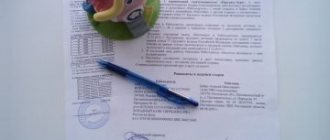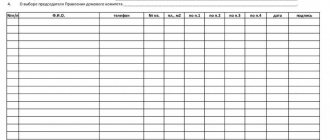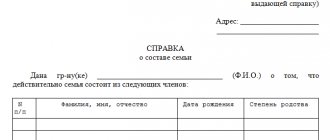To make any important decision necessary for an apartment building, a vote of the owners is certainly held. This process can be performed in several forms, each of which has its own characteristics and purpose. Often it is not possible for all co-owners to attend the next meeting, so you have to resort to absenteeism. Owners of apartments in the building should know how absentee voting of homeowners is carried out, what ballots are used, as well as how to correctly draw up a protocol and count votes.
Absentee voting concept
For any multi-apartment building, the highest governing body is the meeting of owners. It is here that significant decisions are made regarding maintaining the facility in optimal condition.
At such meetings, apartment owners try to improve living conditions, as well as optimize management. The procedure on the basis of which voting is carried out is determined in the charter of the HOA or management company. For a decision to be legitimate, a certain quorum must be present. To do this, it is necessary that at least 50% of the residents of the house take part in the procedure.
If issues related to financial and economic activities are resolved at the meeting, for example, a loan or major repairs are required, then an important feature is the presence of at least 60% of apartment owners.
Residents are notified of the meeting using a special agenda. The form of voting is preliminarily determined. If it is not possible to gather the required number of co-owners, then you have to resort to absentee voting. The procedure assumes that citizens do not gather together in any room, so they receive ballots, which are then filled out at home. Only after they are collected and counted is a decision made.
Features of the correspondence form
The chairman of the HOA must know how absentee voting of homeowners is carried out, as well as what conditions must be met for this. Features of this process include the following:
- held only if it is not possible to organize an in-person meeting in any way;
- the procedure is carried out in several stages, since preparation is initially carried out, after which all residents are notified about the planned vote, and only then the direct procedure of filling out the questionnaire is carried out;
- after summing up the results, the minutes of the meeting are formed correctly;
- all citizens involved in this process must be informed of the results;
- the main stages are carried out by the chairman of the house council, and he can also use the help of the employees of the management company responsible for this building.
Residents can involve management staff in the procedure. They are the ones who prepare absentee voting ballots for homeowners, and also explain to residents exactly how the process is carried out. The management company can independently develop the form and content of the questionnaire.
What issues are being resolved?
When choosing an absentee form of voting for homeowners, many important issues can be resolved. For example:
- it is decided exactly when and with what funds the current or major repairs of an apartment building will be carried out;
- the rules and nuances of landscaping the territory located next to the house are determined;
- a decision is made regarding the possibility of renting out premises belonging to the house;
- the need to increase tariffs for major repairs is assessed;
- the chairman or secretary of the HOA is appointed.
If you understand how absentee voting of homeowners is carried out, you can legally and quickly resolve many important issues that concern each owner of an apartment in such a building. The above list of questions is approximate, so it is possible to make decisions regarding other important points.
Pros and cons of this procedure
The correspondence form has both positive and negative sides. Let's first look at what's good about it.
- The advantage of the correspondence form is that it does not waste time. If to attend a regular meeting citizens had to come after work, or on their day off and devote two hours to HOA issues, then with absentee voting there is no such need.
- The second advantage of absentee voting is that citizens can participate in the choice on their own, even if the whole day is scheduled minute by minute.
- The third advantage is that absentee voting allows you to increase the number of people participating in the survey.
The disadvantages of this form are as follows.
- The fact is that citizens make a decision based on data received somewhere, whereas when participating in an ordinary meeting, problems are discussed, discussed, as a result of which citizens may change their opinion in the process.
- The second disadvantage is that the decision is not always made objectively. Some people check the box at random, while other residents do it for others.
Rules for notifying residents
All apartment owners in the building must be notified in advance of the procedure. To do this, they are sent written notifications. They are compiled by people from the management of the house who decide whether to conduct a survey.
The initiators transmit notifications to all residents of the building, for which they can personally visit apartments or leave documents in mailboxes. Documentation is transferred 10 days before the actual collection. There is no approved form for such notifications, but they must certainly contain the following information:
- information about the persons who are the direct initiators of the survey;
- form of the process;
- date when the procedure will be carried out;
- the time by which all residents are required to return completed ballots;
- the place where the votes of apartment owners will be collected is indicated;
- the agenda of the meeting, and after the transmission of notifications it will be impossible to change this agenda;
- way and time of familiarization with information related to the issues under discussion.
It is allowed to send these notifications to apartment owners by mail. For this purpose, registered letters with return receipt requested are used. If the documentation is handed over to all residents, then it is important to carry out this process against signature.
How is eligibility determined?
In order for post-voting decisions to be valid, certain conditions must be taken into account. These include:
- all owners of apartments located in an apartment building must be notified in advance about the procedure being carried out;
- the votes of all residents are not required, but a quorum is required, so at least 50% of the opponents must vote;
- if any financial issues are being resolved, then it will be necessary to collect votes from 60% of apartment owners.
If a quorum cannot be reached, the vote will have to be repeated.
Process requirements
For voting to be legal, the following requirements are taken into account:
- bulletins that are optimal in content are used;
- optimal quorum is achieved;
- apartment owners are notified about voting in a timely manner;
- important issues are resolved;
- results are properly recorded;
- all residents are notified of the decision made.
Only under such conditions will optimal results be obtained that cannot be challenged.
How is absentee voting of homeowners conducted?
The procedure is considered quite simple, but in order for all decisions made to be legal, the correct sequence of actions must be taken into account. Therefore, the following steps are implemented:
- the reasons why it is impossible to hold a general meeting to implement open voting are determined;
- a notice is drawn up, which contains information about the agenda, and also includes information about all the initiators of this vote;
- within the specified time frame, such notification must be received by each homeowner in the building;
- at a predetermined date, all apartment owners receive bulletins prepared in advance;
- they answer the questions posed in the form of a vote, for which they can choose the following options - for, against, abstain;
- completed forms are transferred to the initiators of voting in the manner specified in the notification;
- votes are counted, after which a protocol is drawn up;
- Based on the results obtained, one or another decision is made.
When drawing up a notification, any suitable form can be used. Absentee voting by homeowners must be held at the time specified in this document.
Why is it carried out?
Article 44 of the Housing Code of the Russian Federation stipulates that the meeting of residents is the highest governing body of the HOA. The meeting can be held either in person, that is, the owners gather at a set time in a certain place, or in absentia - without a general meeting, by polling members of the HOA at their place of residence.
Absentee voting may be conducted in the following situations:
- When you urgently need to make a decision on an issue that does not fall within the competence of the board, and it is impossible to gather all the owners in the shortest possible time.
- In the case when the members of the partnership decide to close it, and the board is trying with all its might to prevent this.
Our people don't like to go to meetings. Bringing them together, even to resolve vital issues, so as to comply with the requirements of the law (more than half of the total number of HOA members must be present), sometimes becomes an impossible task.
Therefore, absentee voting by the HOA is the most acceptable and convenient form of holding a meeting , especially in a building in which many homeowners live.
Rules for creating newsletters
Voting initiators can create their own ballots. They contain information about exactly what issues the owners of apartments in the building need to resolve. It is advisable to study samples of homeowners' absentee voting ballots in order to have an idea of what this documentation looks like.
To make it easy to make a decision, all questions are written accurately and clearly. The document offers three answer options, which allows you to check the boxes next to the desired answer. The sample absentee ballot for homeowners differs only in name. An example of this document can be viewed below.
What it is?
The meeting and voting of owners can be held in several forms:
- full-time;
- correspondence;
- part-time.
The absentee form does not require a simultaneous gathering of participants. Therefore, it often turns out to be more convenient for making a decision.
But there is no possibility of discussion in absentia. Therefore, questions and answers must be formulated in such a way that they can be answered unambiguously. If it is necessary to introduce and discuss options, this can only be done in person. And on the submitted options you can vote in absentia.
Nuances of vote counting
After the voting, the initiative group counts the votes. To do this, the answers to all questions in the ballot are taken into account. Only on the basis of the information available in these documents, the results of absentee voting of homeowners are determined. A sample newsletter can be viewed above.
Only those documents that were transferred by the apartment owners within the established time frame are used. The number of votes is determined based on the area of the apartment in the building. It is allowed for the ballot to be filled out by a representative who has a notarized power of attorney.
Only those votes in which one answer is selected out of three options are counted. If people violate the requirements for filling out the document, then their votes are not counted.
How to prepare ballots for the general meeting of owners?
Ballots for voting at the general meeting of owners are prepared by the initiator of the meeting. This obligation is directly enshrined in paragraph 20 of the Requirements from Order of the Ministry of Construction of the Russian Federation No. 44.
Some initiators prefer to prepare ballots after the face-to-face part of the meeting in order to reflect proposals received during the face-to-face discussion, or to adjust something.
This option is possible, but we must remember: during the in-person portion, legally significant decisions are not made by show of hands; the voting results are determined based on the results of the entire meeting on the basis of written ballots. If written decisions are prepared in advance, then they can be partially distributed and collected during the face-to-face part of the meeting. Requirements for the content of written decisions are contained in Part 5.1 of Art. 48 Housing Code of the Russian Federation, as well as in sub. “g” clause 20 + clause 13 of the Requirements from Order of the Ministry of Construction of the Russian Federation No. 44.
The written decision of the owner must indicate:
- information about the meeting participant – full name. owner (name and OGRN for the legal entity). If a representative participates on behalf of the owner, then his data is needed - full name, name and details of the document certifying his authority - power of attorney, birth certificate, etc.,
- number of the room,
- details of the document confirming ownership of the premises,
- Number of votes,
- decisions on each item on the agenda, expressed in terms of “for”, “against” or “abstained”, that is, information about the will of the participant,
- Date of completion,
- signature.
There is no requirement in the law to indicate information about the owner’s passport in the ballot. Someone adds instructions to the ballot on how to fill it out. You can print it on the back. However, owners are often too busy to read the instructions and fill out the written resolution as they please.
To minimize the number of errors when filling out, it is convenient to immediately print “nominal” ballots, that is, with already completed data about the owner, his premises and documents for the apartment. This data is already in the register of owners. The meeting participant will only have to tick the boxes, date and sign.
Checking ballots during vote counting
It is better to discard incorrectly completed written decisions and replace them with normal ones during collection. When checking during counting, you need to pay attention to:
- Full names are indicated, OGRN is not forgotten for legal entities,
- contains information about the document for the apartment,
- the number of votes is indicated,
- such an owner is in the register of owners,
- there are no opposing marks on the same issue (if there are, the decision on this issue is not considered),
- the date on the ballot corresponds to the period of the meeting,
- there is the owner’s signature at the end of the decision or a signature on each sheet - if there are several sheets in the ballot and it was planned that the owner would sign on each.
Appeal ruling of the Sverdlovsk Regional Court in case No. 33 – 2013/2020. Similar conclusions are contained in the ruling of the same court in case No. 33 – 4/2021: The court invalidated the decisions of the general meeting due to incorrect registration of ballots. They were made on two separate sheets of paper, not stitched or numbered. At the same time, some of the questions posed were on one sheet, and the signatures of the owners and the voting date were on another sheet. “The fastening of these ballots with a stapler and the seal of the Criminal Code does not indicate the proper execution of the decisions of the owners, since the ballots were sent to the Department of State Housing and Construction Supervision with a significant violation of the deadline... In the submitted ballots, either each sheet must be signed, or these ballots must be sealed in such a way in a manner that excludes the replacement of individual sheets where there is no owner’s signature indicating that a decision on the agenda item was made within the prescribed period.”
Particular attention is paid to the voting of representatives , namely documents certifying their powers. The decision itself must indicate the details of such a representative and information about the document on the basis of which he acts, and a copy of this document must be attached to the ballot. If this is a power of attorney, then we check its validity period, content (for what actions it was issued), and the correct authentication of the document.
If the ballot does not meet the requirements, then the court, when challenging decisions, or the housing supervisory authority, when considering the issue of making changes to the register of licenses, may exclude the owner’s decision from the vote count. Some initiators still take these votes into account, guided by the principle “it can’t get any worse.”
Someone draws up a report on invalid ballots, someone indicates information about them at the beginning of the protocol, someone does nothing, but simply silently takes them into account or does not take them into account when counting votes. Regardless of the accounting/non-accounting of ballots with deficiencies, they should not be thrown out, but should be filed along with the rest of the decisions in the minutes of the meeting.
If the ballot as a whole is normal, but on some issue the owner has put two contradictory marks, then the vote of the participant is not counted on this particular issue; the rest of the ballot is considered valid.
the DomOnline website . There, prepare personal ballots for all owners - so that it is easier to fill out and voting participants make fewer mistakes, and at the same time obtain an up-to-date register of owners, count votes and draw up minutes of the meeting.
How are the results compiled?
As soon as the votes are counted, the chairman of the HOA draws up a protocol for the absentee voting of homeowners. When filling it out, the following rules are taken into account:
- the number of all apartment owners in an apartment building;
- how correctly the forms were filled out by citizens;
- whether quorum has been reached;
- whether the voting was carried out correctly, since if serious errors are identified, the results are easily invalidated.
All correctly executed decisions must be entered into the protocol. Additionally, it includes the following information:
- Title of the document;
- date of voting;
- ballot collection location;
- information about the initiators of the process;
- number of apartment owners who voted;
- information about the chairman and secretary of the meeting;
- issues that were considered during the voting process;
- indicates whether the required quorum has been achieved;
- immediate voting results are provided;
- at the end the signature is placed by the chairman and secretary.
The original of this document must be kept by the chairman, and copies are sent within 5 days to the management company, HOA and housing cooperative. A sample protocol for absentee voting of homeowners can be studied below.
How can I appeal the decision?
In this case, as in face-to-face cases, you will have to go to court. You must write a statement of claim indicating:
- Full name of the judicial authority.
- Full name of the plaintiff.
- The essence of the claims.
- Date of application.
An appeal may be made by the owner, whose rights are limited by such a decision and at the same time:
- he didn't vote;
- or voted against such a decision.
The defendant in the case will be the initiator of the meeting.
Attention! You can submit your application within six months after the decision was announced.
The court may satisfy the claim in the following cases:
- In case of significant violations in the conduct of the described processes, including vote counting.
- If the issue does not fall into those categories that can be resolved by the HOA.
The decision may be upheld by the court in the following cases:
- Violations are not significant.
- The participation of this owner in the vote would not have affected the result.
Watch the video for this section:





